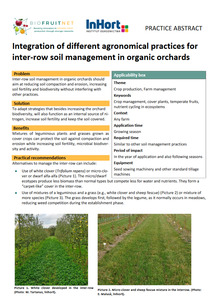{Tool} Integration of different agronomical practices for inter-row soil management in organic orchards (BIOFRUITNET Practice Abstract). Creator(s): Malusa, Eligio and Tartanus, Małgorzata. Issuing Organisation(s): IO-PIB - National Institute of Horticultural Research. Biofruitnet Practice Abstract, no. 053. (2023)
|
PDF
- Published Version
- English
(Integration of different agronomical practices for inter-row soil management in organic orchards)
926kB | |
![[thumbnail of 2024-09-16 16_58_55-Integration of different agronomical practices for inter-row soil management in .png]](/45943/3.hassmallThumbnailVersion/2024-09-16%2016_58_55-Integration%20of%20different%20agronomical%20practices%20for%20inter-row%20soil%20management%20in%20.png)  Preview |
Image (PNG)
- Cover Image
- English
398kB |
Document available online at: https://orgprints.org/45943
Summary in the original language of the document
Mixtures of leguminous plants and grasses grown as cover crops can protect the soil against compaction and erosion while increasing soil fertility, microbial biodiversity and activity.
Practical recommendations
Alternatives to manage the inter-row can include:
• Use of white clover (Trifolium repens) or micro-clover or dwarf alfa-alfa. The micro/dwarf ecotypes produce less biomass than normal types but compete less for water and nutrients. They form a “carpet-like” cover in the inter-row.
• Use of mixtures of a leguminous and a grass (e.g., white clover and sheep fescue) or mixture of more species. The grass develops first, followed by the legume, as it normally occurs in meadows, reducing weed competition during the establishment phase.
• For both cases, a seed quantity of 2 g/m² provides a good density and establishment. However, particularly in the case of micro-clover, water availability (or some irrigation) and full light during the germination phase are needed to ensure good development. The initial development after sowing can be slow in case only legumes are used, but they are resistant to soil compaction by machines.
• Cuts from the inter-row in May-June used as row mulch, can provide up to 50-60 kg N, 10 kg P and 70-80 kg K per ha.
| EPrint Type: | Practice tool |
|---|---|
| What problem does the tool address?: | Inter-row soil management in organic orchards should aim at reducing soil compaction and erosion, increasing soil fertility and biodiversity without interfering with other practices. |
| What solution does the tool offer?: | To adapt strategies that besides increasing the orchard biodiversity, will also function as an internal source of nitrogen, increase soil fertility and keep the soil covered. |
| Country: | Poland |
| Type of Practice Tool: | Practice abstracts |
| Keywords: | Crop management, cover plants, temperate fruits, nutrient cycling in ecosystems |
| Agrovoc keywords: | Language Value URI English crop management http://aims.fao.org/aos/agrovoc/c_16094 English cover plants http://aims.fao.org/aos/agrovoc/c_1936 English temperate fruits http://aims.fao.org/aos/agrovoc/c_7655 English nutrient cycles http://aims.fao.org/aos/agrovoc/c_12869 |
| Subjects: | Environmental aspects > Biodiversity and ecosystem services Crop husbandry > Production systems > Fruit and berries |
| Research affiliation: | European Union > Horizon 2020 > Biofruitnet Poland European Union > Organic Farm Knowledge |
| Horizon Europe or H2020 Grant Agreement Number: | 862850 |
| Related Links: | https://organic-farmknowledge.org/tool/45943, https://biofruitnet.eu, https://organic-farmknowledge.org/tool/42596 |
| Project ID: | ofk |
| Deposited By: | Basler, Andreas |
| ID Code: | 45943 |
| Deposited On: | 26 Apr 2023 06:40 |
| Last Modified: | 16 Sep 2024 14:59 |
| Document Language: | English |
| Status: | Published |
Repository Staff Only: item control page


